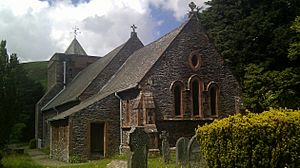All Saints Church, Watermillock facts for kids
Quick facts for kids All Saints Church, Watermillock |
|
|---|---|

All Saints Church, Watermillock
|
|
| 54°35′55″N 2°52′53″W / 54.59874°N 2.88125°W | |
| Location | Watermillock, Cumbria |
| Country | England |
| Denomination | Church of England |
| History | |
| Dedication | All Saints' Day |
| Consecrated | 6 January 1882 |
| Architecture | |
| Heritage designation | Grade II listed |
| Architect(s) | C. J. Ferguson |
| Completed | 1881 |
| Construction cost | £2,050 |
| Administration | |
| Parish | Watermillock |
| Deanery | Penrith |
| Archdeaconry | Carlisle |
| Diocese | Diocese of Carlisle |
| Province | York |
All Saints Church is a special old church in the village of Watermillock, Cumbria. It is a Church of England parish church. This means it serves the local community, including homes and farms near Ullswater lake. The church is also a Grade II listed building. This listing means it is an important historical building that needs to be protected.
Contents
A Look Back: The Church's Story
Early Beginnings
The very first church for this community was built a long, long time ago, in the 13th century. That's over 700 years ago! It was located close to the shore of Ullswater. Sadly, in the 15th century, Scottish raiders burned this old church down.
Building a New Church
After the fire, a new church was built in 1558. This new building was on the same spot where the current church stands today. However, this church was quite simple. In 1880, people described it as being "whitewashed" inside and out. The walls were even green with dampness! It had a gallery, which is like a balcony inside a church, but it didn't have an organ, a special area called a chancel, or proper glass windows.
The Church We See Today
Just one year later, in 1881, that older church was taken down. The current church was then built in its place. It is made from strong slate and beautiful red sandstone. The main part of the church, called the nave, stands on the foundations of the older building. A new section, the chancel, was added on.
In 1884, the church tower was rebuilt to make it taller, giving it the height you see now. The chancel was built to remember Reverend David Pritchard. He was the church's rector from 1876 to 1880.
Inside the Church
Many parts of the church's interior have their own stories:
- The reredos, which is a decorated screen behind the altar, was put in place in 1934. It was a gift to remember Mr T.E. Forster.
- The organ, which makes music for services, was built in 1888 by a company called Wilkinson in Kendal.
- The choir stalls (where the choir sits), the pulpit (where the priest speaks), the pews (where people sit), and the west end screen (a divider at the back of the church) all date back to 1881, when the current church was built.
- The communion table was made more recently, in 1970.
Special Windows and Memorials
In 1889, a beautiful window called the Spring Rice Window was added. It was installed to remember Lady Farrer, whose maiden name was Evelyn Mary Spring Rice. She was born in Watermillock. The church also has stone memorials inside. These memorials remember Sir Cecil Spring Rice and his brother, Lt. Gerald Spring Rice.
See also
- Listed buildings in Matterdale

